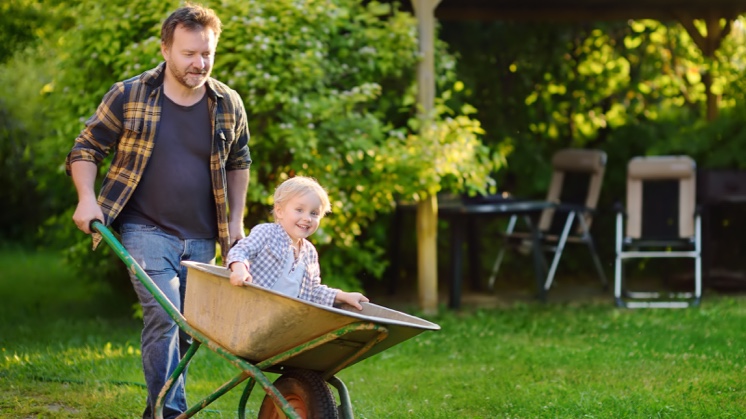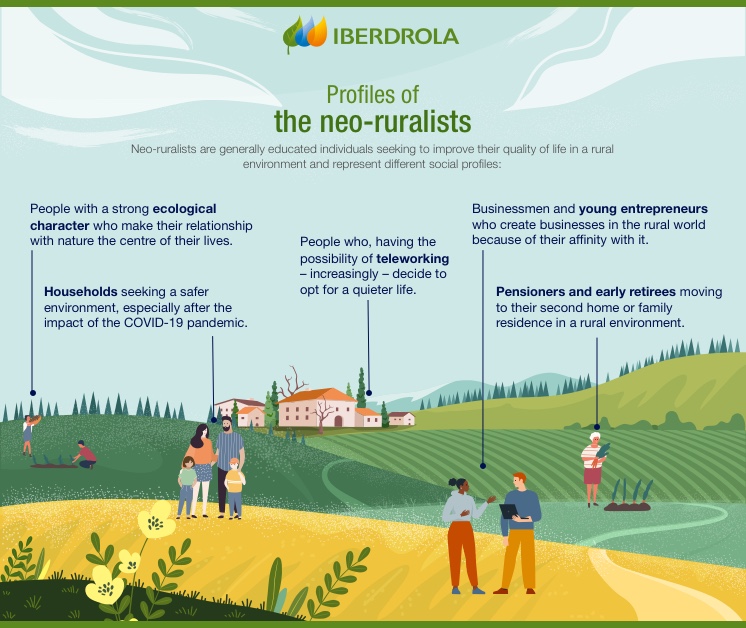Counterurbanization
Counterurbanization, a post-pandemic phenomenon returning to revitalise villages
The desire to get back in touch with nature and away from overcrowded urban centres has increased since the confinement and restrictions resulting from the COVID-19 pandemic. Thus, the phenomenon of counterurbanization or neo-ruralism, i.e. the exodus from the city to the villages in search of healthier and more sustainable lifestyles, has been revitalised around the world.

The confinement, restrictions and threats of resurgence in the wake of the COVID-19 pandemic have fuelled a collective unconscious yearning to escape. This yearning takes many forms, but for most, the most accessible is to move away from cities to rural areas. Now that information and communication technologies (ICTs) have paved the way for teleworking and we have smart villages with broadband internet, it has become easier than ever.
The urban exodus (counterurbanization or neo-ruralism)
In the same way that the First Industrial Revolution produced a flow of migration from the countryside to the city, the Fourth Industrial Revolution, marked by digitalisation, opens the door to the opposite phenomenon: neo-ruralism, i.e. migration from the city to the countryside in search of a better quality of life. Although there are antecedents, such as the Romantic movement in the 19th century, counterurbanization in modern society emerged in the late 1960s in the United States and Europe promoted by members of the counterculture, who fled to the countryside in search of a physical and spiritual reunion with nature.
The rural world in turn feeds on this phenomenon, as neo-ruralists are ecologically aware and do not arrive at their destinations with the intention of altering them, but rather of rehabilitating them. One example is the people who complement their exodus with the opening of rural tourism businesses or those who establish ecovillages to create communities marked by a sustainable lifestyle. Such initiatives encourage the repopulation and economic revival of abandoned and endangered villages around the world.
Motivations of neo-ruralists
Counterurbanization, as already mentioned, is not a new phenomenon, but some sociologists predict a new boom due to the pressure that the COVID-19 pandemic has put on society and the need for society to find escape valves. In any case, there are other motivations:
Environmentalism and self-realisation
Some neo-ruralists disavow city life, emphasising the benefits of natural, organic, local and handmade products in all areas: food, clothing, medicine, etc. True to these principles, they exile themselves in rural areas, trying to live as sustainable a life as possible, in harmony with their environment and working the land in order to be self-sufficient.
Economy and entrepreneurship
On the one hand, life in the countryside is cheaper, especially rents. On the other hand, in recent years there has been an increase in rural-focused businesses, whether in the form of cottages or outdoor activities, which facilitate the emergence of entrepreneurs willing to combine their passion for nature with their profession.
Search for refuge
Without necessarily having strong ecological beliefs, some people tire of the stress of urban life and seek refuge in villages or isolated areas, sometimes in the village where they are originally from. Similarly, there are also families who consider the countryside a safer place to raise their children. The COVID-19 pandemic has exacerbated this trend.

SEE INFOGRAPHIC: Profiles of the neo-ruralists [PDF] External link, opens in new window.
Living in the countryside: advantages and disadvantages
The advantages of rural life are linked to the motivations that drive individuals to move to the countryside, which generally translate, in short, into a higher quality of life. However, life in the countryside has its drawbacks, which may end up outweighing the benefits. These include:
 Reduced leisure offer
Reduced leisure offer
In the rural world, for example, the cultural offer — concerts, cinemas, theatres, exhibitions — is lower and something as human as boredom can be a reason to end up packing your bags and returning to the city.
 Reduced services offer
Reduced services offer
Public transport is poor and a medical emergency can become a problem because of the distance to health centres. Something similar happens with schools and this kind of situation makes life difficult for people who are used to greater comfort.
 Reduced employment offer
Reduced employment offer
The spread of ICTs and the rise of teleworking have opened the door to rural life for many people who would otherwise not be able to leave the city. This does not detract from the fact that, in itself, the number of jobs that can be done in the countryside is limited.
To these problems can be added unexpected inconveniences, such as power cuts or Internet connection cuts that take a long time to repair, or crops that spoil due to bad weather. Situations that always haunt the neo-ruralist and remind him that he no longer lives in the city, for better or worse.
Activities related to counterurbanization or neo-ruralism
The boom in counterurbanization can also be associated with the development of new economic activities linked to rural areas. These include, at present, the following:
- Rural tourism: it is usually divided into accommodation, sports and culture, although they are often combined. For years, rural houses have been an ideal alternative for those who want to disconnect for a weekend. Similarly, sports tourism offers urbanites the opportunity to reconnect with nature while practising a physical activity, such as hiking, canyoning or climbing. On the other hand, excursions to villages with a rich historical heritage are increasingly in demand by tourists who want to discover special places.
- Organic farming: thanks to the growing demand for organic products, it is one of the most widespread activities among neo-ruralists. From single-family homes or communities with gardens from which to harvest food for their own consumption, to young people who see this form of agriculture as a profession and a business opportunity, more and more people are taking up this activity.




